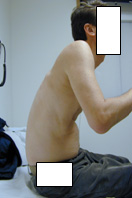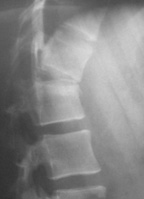Post-Traumatic Kyphosis
Post-traumatic kyphosis occurs most commonly in the thoracolumbar and lumbar regions (mid- to lower-back) after an injury. Patients with post-traumatic kyphosis typically have severe neurologic deficits such as quadriplegia or paraplegia (Figure 1A).
Symptoms
Progressive kyphosis develops in the anterior column and all posterior ligaments of the spinal cord, after an injury. This type of kyphosis can result in chronic, disabling pain.
Sources of pain include:
- Spinal muscle fatigue
- Chronic inflammation and progressive degeneration (worsening)
- Anterior cord or nerve root impingement (pinched nerve[s])
- Problems with sitting balance
- Skin lesions/pressure ulcers in paraplegic patients with severe kyphosis
Trauma patients often have multiple, serious injuries; as such the most common symptom among these patients is pain. The most common complaints among traumatic kyphosis patients include the following:
- Back or neck pain
- Inability to stand up straight
- Excessive lordosis (sway back)
- Feeling of “digestive fullness” resulting from the kyphotic curve putting pressure on gastrointestinal organs
Imaging Evaluation
Complete evaluation, including a neurologic assessment, is important in determining treatment options. Evaluation tools include:
- X-ray images observe the type, location, and severity of injury
- MRI evaluates nerve impingement on the nerves that could cause neurological symptoms
- CT scan assesses the presence of a fracture in the event it is suspected but not perceptible on routine x-ray images
Treatment Options
Traumatic kyphosis can worsen quickly if the injury is allowed to heal without treatment. Options depend on a variety of factors, including the type and site of fracture, the degree of spine curvature, and the size of the patient.
Nonoperative Treatments
- Bracing will support the spine and keep it in a more ideal position as it heals.
- Physical therapy will help lessen pain, strengthen muscles, and improve posture.
Operative Treatments
For traumatic kyphosis that is significant, surgery may the best option for safeguarding quality of life in the future.
- Posteriorspinal fusion with instrumentation is the primary surgical treatment for traumatic kyphosis. The surgeon enters the operative area through the back.
- Anterior-posterior spinal fusion entails 2 incisions, 1 in the front of the body and another in the back.
- Osteotomy, on occasion, may also be necessary to restore alignment. The procedure entails cutting through bone (and possibly removing bone as well).





